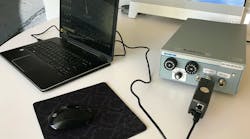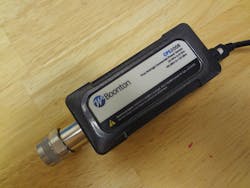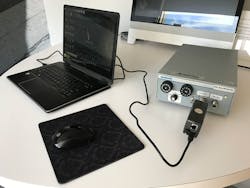Average Power Sensors Don’t Settle for Average Performance
Download this article in PDF format.
In any RF test lab, power sensors are counted on to accurately measure RF power. Determining what power sensor to buy depends on the types of signals that need to be measured, such as continuous-wave (CW) or pulsed signals, along with other factors. This article presents a hands-on look at one of the newest power sensors on the market today from one of the long-standing firms in the industry.
Boonton Electronics, located in Parsippany, N.J., has been at the forefront of RF power-measurement technology for many years. The company, a subsidiary of Wireless Telecom Group, offers a range of power meters and power sensors. One of its latest to hit the market is the CPS2000 Series of true average connected power sensors (Fig. 1).
1. The CPS2000 Series power sensor covers a frequency range of 50 MHz to 8 GHz.
An Overview of the CPS2000 Family
Boonton speaks very highly of the CPS2000 Series—the company boasts that it’s “the most cost-effective average RF power sensor in its class.” But how does it really stack up? Let’s take a look.
Covering a frequency range of 50 MHz to 8 GHz, the CPS2000 sensors can perform true average RF power measurements of CW and modulated signals. The sensors measure signals from 50 MHz to 6 GHz at power levels ranging from −40 to +20 dBm. For signals from 6 to 8 GHz, the measurement range spans −35 to +20 dBm.
One significant aspect of the CPS2000 sensors is measurement speed—they can make over 100 measurements per second. Boonton states that is 3 to 10 times faster than other sensors in the same class, making the CPS2000 Series well-suited for manufacturing test applications.
The CPS2000 sensors are intended to be used in conjunction with a PC. They can connect to a PC via a USB cable and be powered by that same connection. An alternative approach is to connect via Ethernet while powering the sensor using Power-over-Ethernet (PoE). The third option is to connect a sensor to a PC via Ethernet while powering it with a USB power adapter.
To operate the CPS2000 power sensors, one must download the Boonton Power Viewer software from the company’s website (the software is discussed in more detail later on). Furthermore, the sensors are compatible with Windows and Linux systems, and include the necessary drivers for programming.
As mentioned, the CPS2000 sensors are a good fit for manufacturing test applications. Walt Strickler, VP/general manager at Wireless Telecom Group, explains, “The main application for the CPS2000 Series is in manufacturing test. In that application, RF power measurement is typically a coarse measurement. With the addition of wireless technologies to so many products (e.g., the Internet of Things, machine-to-machine, vehicle-to-vehicle, and vehicle-to-infrastructure), more products than ever have wireless connectivity. In most cases, companies buy pretested wireless modules and simply need to do a quick verification when included with their products. A cost-effective average sensor is ideal for that application.”
The CPS2000 In Action
So, how well does the CPS2000 Series perform? We put the sensor to work. Figure 2 shows a CPS2000 sensor connected to a Boonton demo aid that’s capable of generating various signals. The sensor is connected to a laptop with a USB cable.
2. In this setup, a CPS2000 Series power sensor is measuring a signal from a Boonton demo aid.
As mentioned previously, the CPS2000 sensors are used with the Boonton Power Viewer software. Figure 3 shows the software’s graphical interface when making a power measurement. In this case, a 2-GHz CW signal from the demo aid is being measured.
Users have three options for displaying power measurements when applying this software. One option is to display measurements with just text. Alternatively, users can choose to have power measurements displayed with a gauge. The third option is to view measurements with both text and a gauge, as is the case for the measurement shown in Fig. 3. Furthermore, users can display measurements in either dBm or watts.
3. Here, the Boonton Power Viewer software displays a power measurement reading of −9.239 dBm.
In addition, users can specify Aperture, which is defined as the total time that the sensor observes the input signal to make one power measurement. Aperture can range from 1 ms to 2 s. For the measurement in Fig. 3, Aperture was set to 50 ms. Fig. 3 also reveals the Offset text box, which allows users to apply corrections to measurements.
Another key feature is the Live Power vs. Time graph, shown at the bottom of Fig. 3. This aspect allows power to be monitored over a specified time interval. In this example, the time interval was set to 30 s. Checking Auto-scroll enables power measurements to be continuously monitored over time.
Lastly, the software supports connections to as many as eight different sensors. To connect to additional sensors, users must click Add Device. When multiple sensors are connected, the software also allows for ratio measurements.
Closing Thoughts
From my perspective, I think the CPS2000 Series is a worthy addition to Boonton’s product line. It offers proven performance for those in need of average-power measurements. I also found the Boonton Power Viewer software to be very easy to operate. It features a simple interface that should have a familiar feel to those with experience using power meters/sensors. And while the gauge-display feature may not seem necessary for people like myself, others are likely to appreciate it.
Furthermore, the Live Power vs. Time graph is a nice feature that’s easy to use. One should be aware that Boonton only lets users select from six different time-duration options: 10 seconds, 30 seconds, one minute, five minutes, 30 minutes, and one hour. One suggestion of mine would be to provide more options and/or allow users to enter their own time duration.
If you’re in need of a power sensor, you may want to consider the CPS2000 Series. The sensors have a price tag of $1,395.




